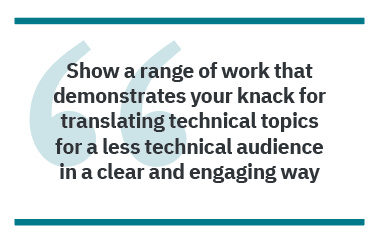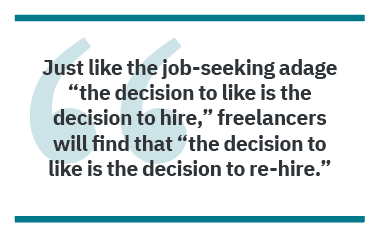By Bonnie Denmark | STC Member
Tips to gain a competitive edge
Technical content is big business and only expected to grow, thanks in part to the boom in digital products and new ways of working sparked by the pandemic. As companies struggle to keep up with content demands, opportunities for technical communication freelancers are on the rise.
Hayden Brown, CEO of UpWork, the world’s largest freelance marketplace, doesn’t see a return to the old ways of working. In an August 2021 New York Times interview, she noted that younger generations in particular have a more “empowered idea around how they’re going to build their careers that’s much more autonomous and not related to a single firm.”1
But with increased opportunity comes more pressure to stand out from the crowd. It pays to be strategic, so here are some tips that can help you position yourself as a freelancer to be more attractive to potential hirers.
Make Your Online Profile Count
The starting line for many is a profile on a freelancer website. Some sites truncate bios after the first 100 or so characters, so use your space wisely to invite potential hirers to read on. Frontload the most relevant information, as in “Health and medical writer who turns tough medical text into readable, user-friendly language” or “B2B/B2C content: documentation, user guides, and web content for apps/software; troubleshooting; marketing.”
A not-so-good use of your small window to impress is, “Father of two who….” (yes, this happens).
If you include links to external sites, have the links open in a new window, leaving your original tab in place. Otherwise, the potential hirer may be tempted to go down a rabbit hole of interesting clicks and end up too many back-arrows away from your profile to care enough to slog their way back (not admitting guilt — well, sort of).
Build a Portfolio
If you are just launching your career as a freelancer, develop a portfolio of work samples in an industry or subject area that interests you. For example, Big Pharma is worth hundreds of billions of dollars and presents many opportunities for outsourced content. In addition to highly specific content like FDA applications and testing protocol reports, pharmaceutical companies generally have consumer-facing web pages. Thus, a company that develops veterinary medicine might welcome an article or blog post on special concerns for the senior dog, with a focus on a disease treated by medicine that the company produces.
Show a range of work that demonstrates your knack for translating technical topics for a less technical audience in a clear and engaging way. Your samples could include user guides, software or hardware documentation, online help, FAQs, product descriptions, catalog blurbs, or informational web pages. If you have created videos or scripts, include them. Vidyard and Demand Metric2 reported a 254% increase between 2019 and 2020 in organizations producing more than 50 videos.
And don’t neglect the growing need for business-to-business (B2B) content. Robust industry segments that rely on specialized technology include hospitality, shipping/logistics, real estate, finance, and medical technology/HealthIT.
Pick Your Poison: Generalist or Specialist?
Forbes contributor Jon Younger3 interviewed business leaders about opportunities and challenges facing freelancers. The most common advice reported was to establish an area of specialization, even hyper-specialization, rather than compete with generalists, especially when it comes to tech. As Nigel Sarbutts, founder of the freelance platform PR Cavalry, put it, “Go deep, go niche, and thrive.”
Specialization brings definite advantages. If you specialize in a subject area, your freelance business may ramp up more quickly. You spend less time gathering the background needed for new assignments, and you have a better chance of well-paying clientele passing your name around in a certain segment.
But not everyone is in the “go niche or go home” camp. Some technical subjects can be adequately addressed with intellectual curiosity and solid research skills — and a talented generalist has the versatility to fill many needs at a company. As a generalist, you may find yourself becoming the go-to person for all things editorial, allowing you to forge contacts across teams or departments. An added bonus is a natural immunity to “insider’s syndrome.” Those with deep sector knowledge can’t un-know what they know. Specialists may have a harder time assuming a naïve user’s perspective that could facilitate a connection with the audience.
 Mind Your Business — and Your Wallet
Mind Your Business — and Your Wallet
Sidestepping misunderstandings with customers protects your bottom line. Once you land an assignment, be clear from the outset about what the scope of the project is, how many revisions are expected, who the stakeholders are that you depend on for sign-offs, how many iterations of a document you are expected to participate in, and where the project is in the development cycle so that you can estimate the number of tweaks.
To reduce the number of revisions, request that stakeholders who must approve the final product also sign off on an outline and draft. It’s no fun when the person they forgot about comes in at the 11th hour with a load of changes.
Some companies assign a writing task as a tryout, and most will treat it as a paid assignment. Not all companies, however, compensate contenders for their writing trials. Before you accept an unpaid assignment, think about how much you want the job or the association with this particular company. If the sample requested is long or complex, and you still wish to pursue it, a reasonable compromise might be to provide an outline and a fleshed-out section or two. The outline will reveal your sense of content architecture, and the completed sections will show your writing style.
Bridge the Gap Between Technical Communication and Marketing
As marketing budgets have hit an all-time low,4 the integration of marketing and technical communication has become increasingly important. Technical content in its many forms has a place along the entire customer journey, both pre-sale and post-sale, and the customer’s experience with technical content can be a big factor in a purchase decision for both business-to-consumer (B2C) and B2B sales.
Today’s tech-savvy consumers want a solid understanding of the product or service before they buy, and surveys show that buyers spend the majority of their time in background research before even speaking to a seller.5,6 In their initial exploration, potential customers may check out a website or blog, look at FAQs, view a video or webinar, investigate online demos, seek out user reviews, and more. Even well-written product instructions can act as a sales tool as buyers compare their options.
Include some lively, short-form content in your portfolio, and work in some copywriting techniques. Lighten the tone, perhaps even dipping a toe into “infotainment” (with caution). Infuse some journalistic flair, tell a story, and bring in the why, as well as the how. You might begin a how-to guide or getting-started tutorial with a short introduction that mentions how the product or service will benefit the user (why they want it). Next comes your clear, concise, and friendly tech content (how they will use it). Finally, wrap up the piece with a “looking forward” conclusion — a call to action, however informal (e.g., “Contact us for more information”), advice on what to do if the user experiences a problem (with a link to troubleshooting material), a goodwill message, or an invitation to leave feedback.
 Channel Your Customer
Channel Your Customer
Familiarize yourself with your customer’s website and social media to get a feel for their tone and persona. Do they lean more toward light and breezy or serious and authoritative? Pay attention to punctuation, sentence length and structure, point of view (use of “you” and “we”), and word choice. Do they use sentence fragments, contractions, dashes, and exclamation points? Or are they semicolon types who write in full sentences?
Maggie Koerth-Baker, a celebrated science journalist who has earned her distinctive voice, recalls her early years as a freelancer “absorbing the voices of publications and vomiting that back” — which she still feels is “insanely good when you’re starting out, because it makes you [seem to editors] like you need less editing.”7
Reinforce Your Image as a Professional Writer
In an industry survey, Carliner and Chen8 found that second only to understanding the subject matter, technical communicators were expected to have excellent writing and editing skills. This is a given for professional writers, but how do you establish your writing competence early on?
Love is in the details, so keep the following in mind:
- Write for re-use: Even if you are not writing for machine readability, principles of sound content architecture apply to all documents. Incorporate a modular, topic-based design around chunks of text that can be recombined and repurposed for various needs and begin informative headings with meaning-laden words.
- Make it pretty: Use formatting features for clarity, accessibility, and attractiveness.
- Check your work: Don’t leave all the editing to an editor; sloppy mistakes are a turnoff that will damage your reputation.
- List your sources: Referring to “a recent survey” without giving the date and author of the study is not sufficient.
- Keep an eye on version control: Keep track of who has seen each version of the document. If you do not have instructions on the customer’s file-naming conventions, include the project, your initials, the date, and the draft or revision number — e.g., “MRI-faq.rev1.bd.121521.” Hold on to interim versions of the document until you have been paid for the final deliverable.
- Make the most of your time with a subject matter expert: If you have the opportunity to interview a subject matter expert, act as if you have one shot to get the information you need. One respondent to Carliner and Chen’s survey expressed that having to explain something more than once is “very frustrating.”8 Do your research beforehand, don’t leave the interview without the information you require, ask for clarification when needed, or rephrase information to check your understanding. You may want to ask to record the conversation.
- Tap the testers: If you have access to testers, they can be your best resource, as they can give you a more authentic user perspective unimpeded by insiders’ assumptions.
- Ask about style: Ask new customers if they have an in-house style or follow an existing style manual. If yes, great; your job will be easier. If not, great as well; your query will add to their perception of you as a writing professional. In the absence of a style guide, you can gather guidelines from the company’s website on specifics like heading capitalization, dash type, “data is” versus “data are,” abbreviations, and serial commas. Create your own style guide for more efficient writing, as well as for future projects with that organization. If the company is aware of a guide you create, you will be seen as their writing expert.
 Play Well with Others
Play Well with Others
Service with a smile goes a long way for technical communicators. If you establish ongoing relationships with key customers, work can be steady — this is easier than chasing down a series of one-off projects for different companies. Steady clients mean less time to get up and running on each new assignment, fewer misunderstandings regarding the customer’s process and expectations, and a greater chance of working on related projects and thus less chance of wasting unused research.
The likability factor is influenced by your flexibility, timeliness, and pleasantness in interactions with others, so communicate, remain open to others’ ideas and criticism, always be polite and professional, and be mindful of turnaround time. Just like the job-seeking adage “the decision to like is the decision to hire,” freelancers will find that “the decision to like is the decision to re-hire.”
References
- Gelles, David. 2021. “How Freelancing Is Changing Work.” The New York Times, August 13, 2021. Accessed August 13, 2021. https://www.nytimes.com/2021/08/13
/business/hayden-brown-upwork-corner-office.html?smid=fb-nytimes&smtyp=cur&fbclid=IwAR3PB
-F71-EGIZYNiabxa8OSrIa2req70k4qreLkG8wpTIiAhoAJ_QACEXo. - Vidyard, in partnership with Demand Metric. 2020. The State of Video: 2020 Edition. Accessed August 22, 2021. https://www.vidyard.com/resources/state
-of-video-report/. - Younger, Jon. 2021.“Making It as a Freelance Writer: Platform CEOs Share Their Forecast.” Forbes, April 23, 2021. Accessed August 1, 2021. https://www.forbes
.com/sites/jonyounger/2021/04/23/making
-it-as-a-freelance-writer-platform-ceos-share-their-forecast/?sh=448e211378f0. - Blum, Kelly. 2021. “Marketing Budgets Drop to Lowest Levels in Recent History.” Gartner. Accessed August 11, 2020. https://www.gartner.com/en/marketing/insights
/articles/marketing-budgets-drop-to-lowest
-levels-in-recent-history. - 2020. “New B2B Buying Journey & Its Implication for Sales.” Accessed July 17, 2021.
https://www.gartner.com/en/sales/insights
/b2b-buying-journey. - GE Capital Retail Bank. 2013. “GE Capital Retail Bank’s Second Annual Shopper Study Outlines Digital Path to Major Purchases.” Accessed July 30, 2021. https://www
.ge.com/news/press-releases/ge-capital-retail-banks
-second-annual-shopper-study-outlines-digital-path-major - Yong, Ed. 2020. “A Conversation with Maggie Koerth-Baker on ‘The Complicated Legacy of a Panda Who Was Really Good at Sex.’” In The Craft of Science Writing, edited by Siri Carpenter, 273–278. Madison, WI: The Open Notebook.
- Carliner, Saul, and Yuan Chen. 2021. “Expectations of Technical Communicators.” Intercom Magazine 68, January/February: 14–17.
 BONNIE DENMARK (denmarkb@wcsu.edu) has hired freelancers, managed and edited freelancers, and been a freelancer herself. She started in the tech field as a computational linguist and software developer in the early days of grammar checkers on personal computers and later enjoyed a career as a technical communicator, mostly in health and science. After 25 years, Bonnie left the day-to-day world of content creation and now coordinates the Business & Technical Writing option at Western Connecticut State University.
BONNIE DENMARK (denmarkb@wcsu.edu) has hired freelancers, managed and edited freelancers, and been a freelancer herself. She started in the tech field as a computational linguist and software developer in the early days of grammar checkers on personal computers and later enjoyed a career as a technical communicator, mostly in health and science. After 25 years, Bonnie left the day-to-day world of content creation and now coordinates the Business & Technical Writing option at Western Connecticut State University.


